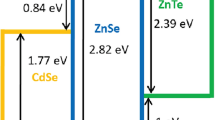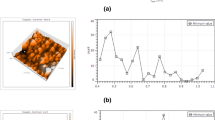Abstract—
The influence of iron and copper nanoparticles of different sizes on the physico-chemical processes occurring in colloidal solutions during laser breakdown has been investigated. The water dissociation occurring under the action of breakdown plasma is characterized by generation of hydroxyl radicals. It is found that both the material of nanoparticles and their size affect the processes of hydroxyl radical generation under the action of laser breakdown plasma.





Similar content being viewed by others
REFERENCES
L. M. F. Batista, V. K. Meader, K. Romero, K. Kunzler, F. Kabir, A. Bullock, and K. M. Tibbetts, “Kinetic control of [AuCl4]—photochemical reduction and gold nanoparticle size with hydroxyl radical scavengers,” J. Phys. Chem. B.123 (33), 7204–7213 (2019). https://doi.org/10.1021/acs.jpcb.9b04643
E. V. Barmina, A. V. Simakin, and G. A. Shafeev, “Hydrogen emission under laser exposure of colloidal solutions of nanoparticles,” Chem. Phys. Lett. 655, 35–38 (2016). https://doi.org/10.1016/j.cplett.2016.05.020
D. Amans, W. Cai, and S. Barcikowski, “Status and demand of research to bring laser generation of nanoparticles in liquids to maturity,” Appl. Surf. Sci. 488 (15), 445–454 (2019). https://doi.org/10.1016/j.apsusc.2019.05.117
A. V. Simakin, M. E. Astashev, I. V. Baimler, O. V. Uvarov, V. V. Voronov, M. V. Vedunova, M. A. Sevost’yanov, K. N. Belosludtsev, and S. V. Gudkov, “The effect of gold nanoparticle concentration and laser fluence on the laser-induced water decomposition,” J. Phys. Chem. B.123 (8), 1869–1880 (2019). https://doi.org/10.1021/acs.jpcb.8b11087
A. Vogel, K. Nahen, D. Theisen, and J. Noack, “Plasma formation in water by picosecond and nanosecond Nd:YAG laser pulses—part I: Optical breakdown at threshold and superthreshold irradiance,” IEEE J. Sel. Top. Quantum Electron. 2 (4), 847–860 (1996). https://doi.org/10.1109/2944.577307
P. Wagener, A. Schwenke, B. N. Chichkov, and S. Barcikowski, “Pulsed laser ablation of zinc in tetrahydrofuran: Bypassing the cavitation bubble,” J. Phys. Chem. C.114 (17), 7618–7625 (2010). https://doi.org/10.1021/jp911243a
L.M. Lyamshev, “Optoacoustic sources of sound,” Sov. Phys.-Usp. 24 (12), 977–995 (1981).
J. Noack and A. Vogel, “Laser-induced plasma formation in water at nanosecond to femtosecond time scales: Calculation of thresholds, absorption coefficients, and energy density,” IEEE J. Quantum Electron. 35 (8), 1156–1167 (1999). https://doi.org/10.1109/3.777215
A. De Giacomo, R. Gaudiuso, C. Koral, M. Dell’Aglio, and O. De Pascale, “Nanoparticle enhanced laser induced breakdown spectroscopy: Effect of nanoparticles deposited on sample surface on laser ablation and plasma emission,” Spectrochim. Acta, Part B.98, 19–27 (2014). https://doi.org/10.1016/j.sab.2014.05.010
M.-R. Kalus, R. Lanyumba, N. Lorenzo-Parodi, M. A. Jochmann, K. Kerpen, U. Hagemann, T. C. Schmidt, S. Barcikowski, and B. Gökce, “Determining the role of redox-active materials during laser-induced water decomposition,” Phys. Chem. Chem. Phys. 21 (34), 18636–18651 (2019). https://doi.org/10.1039/C9CP02663K
V. E. Ivanov, A. M. Usacheva, A. V. Chernikov, V. I. Bruskov, and S. V. Gudkov, “Formation of long-lived reactive species of blood serum proteins induced by low-intensity irradiation of helium-neon laser and their involvement in the generation of reactive oxygen species,” J. Photochem. Photobiol., B.176, 36–43 (2017). https://doi.org/10.1016/j.jphotobiol.2017.09.012
Funding
This study was supported by the Russian Foundation for Basic Research, project no. 19-02-00061-a and (in part) project nos. 18-52-70012-e-Asia-a and 18-32-01044-mol_a, and program no. 5 “Photonic Technologies in Sensing Inhomogeneous Media and Biological Objects” of the Presidium of the Russian Academy of Sciences.
Author information
Authors and Affiliations
Corresponding author
Additional information
Translated by Yu. Sin’kov
About this article
Cite this article
Baimler, I.V., Simakin, A.V., Uvarov, O.V. et al. Generation of Hydroxyl Radicals during Laser Breakdown of Aqueous Solutions in the Presence of Fe and Cu Nanoparticles of Different Sizes. Phys. Wave Phen. 28, 107–110 (2020). https://doi.org/10.3103/S1541308X20020028
Received:
Revised:
Accepted:
Published:
Issue Date:
DOI: https://doi.org/10.3103/S1541308X20020028




